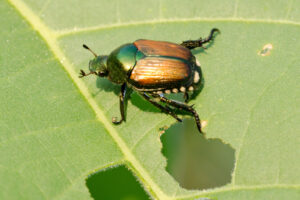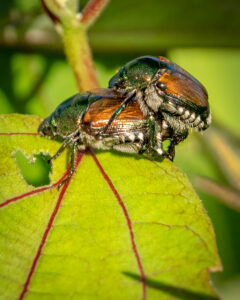
Don’t be fooled, these iridescent green beauties can destroy your garden. Whether you’re pruning ornamental landscape plants or providing fresh veggies for your family, you’ve come across the adult version of the grub. Popillia japonica feed on over 300 varieties of plants and trees, unlike the typical native insects that are specialty feeders. Therein lies the problem, Japanese Beetles eat everything in site.
When looking to ID Japanese Beetles, look for skeletonized leaves and flowers. A quick scan of the surrounding environment should identify the culprit. If hand-picking, beware, they drop to the ground underneath quickly and ID’ing them once they’ve dropped is tougher.

Unhealthy brown patches in your lawn are a potential sign of grubs, their feasting causes dead or dying grass in your lawn. The beetles themselves are ½ inch in length with metallic blue-green heads. They have copper-colored backs, tan wings, and small white hairs lining each side of their abdomen.
Surefire ways to get rid of Japanese Beetles without chemicals
Hand picking –
Trapping –
Planting resistant plants –
Row covers –
RESISTANT to Japanese Beetles | VULNERABLE to Damage from Japanese Beetles | ||
Trees & Shrubs | Herbaceous Plants | Trees & Shrubs | Herbaceous Plants |
Arborvitae Ash Boxwood Burning Bush Dogwood Forsythia Hemlock Hickory Holly Juniper Lilac Magnolia Northern Red Oak Pine Redbud Red Maple Spruce Sweetgum Tulip Poplar Yew | Ageratum Begonia California poppy Columbine Coral Bells Coreopsis Dusty Miller Forget Me Not Foxglove Hosta Impatiens Lantana Larkspur Lily of the Valley Moss Rose Nasturtium Pachysandra Pansy & Viola Poppy Showy Sedum | American Mtn Ash Apple & Crabapple Beech Birch Black Walnut Crape Myrtle Hawthorn Horse-chestnut Japanese Maple Larch Linden Lombardy Poplar Norway Maple Plum, Apricot, Cherry, Peach Pin Oak Rose of Sharon Sassafras Summersweet Virginia Creeper Willow | Asparagus Cardinal Flower Clematis Common Mallow Daisy Dahlia Evening Primrose Gladiolus Grape Hibiscus Hollyhock Lily Morning glory Peony Red Raspberry Rhubarb Rose Soybean Sunflower Sweet Corn Zinnia |
Eliminate the problem before it starts with these preventive measures:
Grub-eating Nematodes (Heterorhabditis bacteriophora)
BT (bacillus thuringiensis)
Milky Spore (Bacillus papillae)

Don’t Get F*&^ed
All said and done, like other pests, Japanese Beatles can turn a fun, relaxing hobby into a devastating uphill battle. However, with proper prep, some advance planning and options for if/when they arrive, you’ll be able to continue gardening in relative peace and quiet, until the next swarm.
